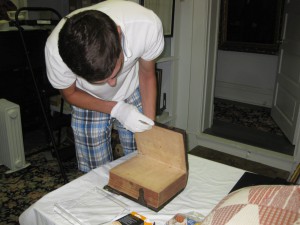
Sam Vaught ’16 – I have spent the last six weeks of summer working at the Montgomery County Historical Society. As a Mont. Co. native, I was familiar with the work of the Society before I came to Wabash; I knew about Lane Place, the Victorian house museum in downtown Crawfordsville; the Speed Cabin and its connection to the Underground Railroad; and much of the other behind-the-scenes work MCHS does to preserve and record county history. My involvement grew when I entered Wabash two years ago, and I became a regular volunteer. When I had the opportunity to apply for an internship here, I couldn’t pass.
When most people hear the word museum, they probably think of dark, dusty rooms full of artifacts from generations of forgotten individuals and institutions. I’m not going to lie; that is a major aspect of life in a museum. I have spent a lot of time turning pristine white cotton gloves (a must-have for object handling) into reddish-brown rags, digging through the lives of Crawfordsville residents who have been dead for more than a century.
However, there is so much more to working in a museum. There is so much that goes on in this place, and through this place, that would be invisible to the casual observer. This summer, I have learned how to look beneath the surface of what might seem like an ordinary museum in order to have a glimpse at what an institution like an historical society might have to offer the community. And isn’t that what the Wabash education is all about? Being taught and teaching ourselves how to look for the other perspective, how to dig deeper into the complexities of an idea to arrive at a more thorough, more educated understanding? I think so.
Care for artifacts and our historic house are certainly near the top of our priority list. We also do a good deal of research, whether preparing for next year’s exhibit or next week’s presentation to the community. Side note: In an exciting bit of hunting for the provenance (professional jargon for origin) of three coats of arms we have in the collection, I have made contact with the Royal College of Arms of the British government. Be jealous. While I spend a fair amount of time photographing antique books, learning how to care for aging textiles, and examining damaged wallpaper, I have also spent a surprising amount of time interacting with the community. For example, last week, the Historical Society held its annual Golf Scramble at the Crawfordsville Country Club. The event was not just a fundraiser for the ever stretched-thin Society. It was a chance for us to meet new people, reconnect with old friends, and stay relevant in a world decades removed from most of the culture we are surrounded with inside Lane Place. Museums have an important place in our community, and when we celebrate and engage that community, we are better living into our mission to serve the people of this county.
Giving tours of the house is a great way to gauge how the public perceives the Society and the museum. I have given countless tours to folks who tell me that they’ve lived in the city or the county their entire lives but have never set foot in the house. At the same time, we get visitors from out of state who are itching to see the mansion they’ve read about in our tourism information or seen online. On the other hand, many locals are surprised when they hear that the Historical Society has an oral history project that collects the stories of Montgomery County residents before they are lost. These experiences have taught me that we have some work to do. We at the Historical Society need to do a better job at interacting with the community. We need to let others know about our programs, services, and educational opportunities. On the same token, the Crawfordsville community has the responsibility to engage with those institutions which they support. It is easy to take Lane Place for granted. “It’s the big white house I drive past every day.” “It’s the park where we have the Strawberry Festival.” But if I’ve learned nothing else this summer, it is that there is always more than meets the eye in a place like ours. Those beautiful moments of connection happen when the child sees the Civil War surgeon’s kit and finally has some idea of the horrors of that war. They happen when the 75 year old woman sees our antique washing machine and suddenly remembers the smell of her great-

grandmother’s house. They happen when the boy who grew up next to Lane Place records his memories of Helen Elston Smith, the last family resident of our mansion, in our oral history project.
I will leave this museum in a few weeks to return to campus. But I will always take with me the importance of giving something, or someone, a second glance to find more authenticity, more value, and more humanity present than I thought before.